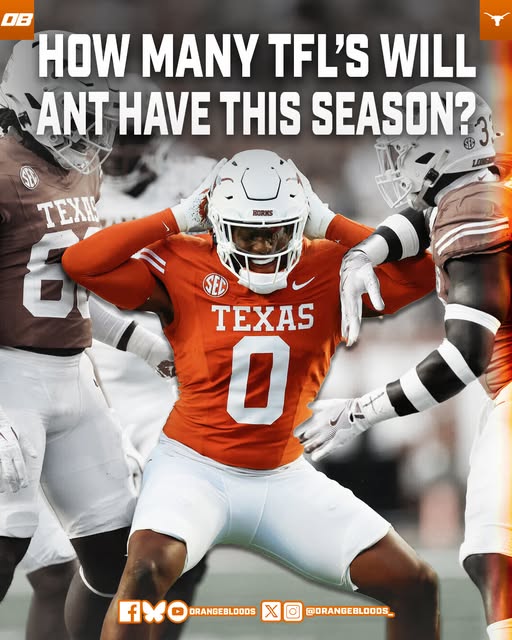Anthony Hill is entering this football season with a spotlight on his ability to disrupt offenses behind the line of scrimmage. Last year, he recorded an impressive 16.5 tackles for loss (TFLs), marking him as one of the most impactful defensive players on his team. As fans and analysts alike look ahead to the upcoming season, the burning question remains: how many tackles for loss will Anthony Hill have this year? To answer this, it is essential to analyze his past performance, his role within the defense, team dynamics, the opponents he will face, and the factors that could influence his productivity on the field.
Last season’s 16.5 TFLs put Hill in a highly productive category. Tackles for loss are a critical defensive statistic that demonstrate a player’s ability to penetrate the offensive line and stop plays before they can develop. For a linebacker or defensive lineman, TFLs are a hallmark of aggressive, smart, and physically dominant play. Hill’s ability to achieve this number is a testament to his instincts, athleticism, and understanding of offensive schemes. His 16.5 TFLs not only disrupted the rhythm of opposing offenses but also often set up his team with favorable field position and momentum shifts.
Looking deeper into the context of Hill’s 16.5 tackles for loss last year, several factors contributed to that success. Firstly, his role in the defensive scheme was pivotal. As a primary pass rusher and run stopper, Hill was frequently tasked with reading plays quickly and attacking gaps before the offensive line could adjust. His position often placed him in prime spots to make impactful plays behind the line. Moreover, the defensive coordinator’s scheme likely emphasized aggressiveness and leveraged Hill’s talents by giving him freedom to blitz or stunt through blocks, increasing his chances of making TFLs.
Another significant factor is Hill’s physical and mental growth as a player. Over the offseason, players like Hill typically engage in rigorous training regimens designed to improve speed, strength, agility, and football IQ. This ongoing development often translates to improved performance on the field. If Hill has continued to build on his strengths and address any weaknesses from last season, he should be even more effective at disrupting plays. His understanding of opponents’ tendencies and offensive formations should also be sharper, allowing him to anticipate plays and position himself to make more tackles for loss.
The supporting cast around Hill also matters. Football is a team sport, and a player’s ability to rack up TFLs can be influenced by the performance of teammates. For example, if the defensive line consistently occupies blockers effectively, Hill can exploit the gaps and get to the ball carrier more easily. Conversely, if the team struggles in run defense or the front seven lacks cohesion, Hill might face greater challenges getting to the ball carrier, which could impact his TFL numbers. Team chemistry and coordination can elevate individual performances, and the overall defensive unit’s quality will be a factor in Hill’s production.
The level of competition Hill will face this season is another vital element to consider. If his team plays against offenses with strong offensive lines and quick backs, achieving a high number of tackles for loss can be more challenging. Defensive players often see their stats dip when facing well-coached and fundamentally sound offenses that can adjust their blocking schemes or use misdirection to neutralize edge rushers. However, if Hill’s schedule includes several teams with weaker or less experienced offensive lines, it could provide more opportunities for him to make plays behind the line of scrimmage.
Injury risk and durability are other variables that cannot be overlooked when projecting statistics like tackles for loss. Hill’s ability to stay healthy throughout the season will directly affect how many opportunities he has to make impactful plays. Football is a physically demanding sport, and even the most talented players can see their seasons cut short or limited by injury. Fortunately, if Hill has remained healthy and prepared, he should be able to build on last year’s success.
Looking at comparable players and historical data can also help forecast Hill’s potential TFLs this season. Players who recorded around 16 tackles for loss one year often see similar or slightly higher numbers the following season if they maintain or improve their physical and mental game. If Hill continues on an upward trajectory and his defense remains aggressive, it would not be surprising for him to increase his tackles for loss total to somewhere between 17 and 20. That would solidify his reputation as one of the premier defensive playmakers in his league.
Another aspect to consider is the evolution of the game and coaching strategies. Modern offenses have become increasingly dynamic, incorporating quick passes, read-option plays, and fast tempo. While this can sometimes reduce opportunities for tackles for loss because plays are designed to get the ball out quickly, it also demands that defensive players be versatile and explosive. Hill’s ability to adapt to these evolving offensive tactics by being quick off the snap and versatile in his approach could enhance his chances of making tackles for loss despite these challenges.
Hill’s leadership role on the defense could also play a role in his production this season. As a proven impact player, he may take on greater responsibility in calling defensive adjustments and motivating teammates. This added responsibility can often inspire players to elevate their game. With increased confidence and authority, Hill might be more aggressive and decisive in his pursuit of tackles for loss.
It is also worth mentioning that tackles for loss are not just a reflection of individual talent but also game flow and situational factors. Defensive players often get more chances for TFLs when their team is leading and the opponent is forced to run plays in predictable ways. Conversely, if Hill’s team spends much of the season defending in tight games or behind in score, offenses may lean on quick throws and short gains, limiting TFL chances. The overall competitiveness of Hill’s team will influence the game situations he faces, thereby impacting his stats.
Finally, the mental aspect of the game cannot be underestimated. Confidence and momentum play significant roles in a defensive player’s success. Last season’s strong performance could serve as a springboard for Hill to attack this season with even more intensity and focus. On the other hand, opponents will also be more aware of his threat and may game-plan specifically to neutralize him. How Hill responds to being a marked man on the field will be crucial in determining whether he can sustain or improve upon last season’s tackles for loss total.



